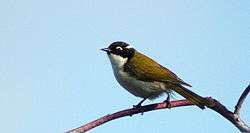Gilbert's honeyeater
| Gilbert's honeyeater | |
|---|---|
 | |
| Scientific classification | |
| Kingdom: | Animalia |
| Phylum: | Chordata |
| Class: | Aves |
| Order: | Passeriformes |
| Family: | Meliphagidae |
| Genus: | Melithreptus |
| Species: | M. chloropsis |
| Binomial name | |
| Melithreptus chloropsis (Gould, 1844) | |
| Synonyms | |
| |
Gilbert's honeyeater (Melithreptus chloropsis), also known as the Swan River honeyeater or western white-naped honeyeater, is a passerine bird of the honeyeater family Meliphagidae native to south-western Australia.
Taxonomy and naming
Gilbert's honeyeater was originally described by John Gould in 1844, who gave it the species name chloropsis from the Ancient Greek terms chloros "green-yellow" and opsis "eye".[1] Gregory Mathews coined the name Melithreptus whitlocki in 1909.[2]
Treated as a subspecies of the white-naped honeyeater for many years, it was found in a 2010 study to have diverged early on from the lunatus complex. It forms a superspecies with the white-naped and black-headed honeyeaters.[3] It is a member of the genus Melithreptus with several species, of similar size and (apart from the brown-headed honeyeater) black-headed appearance, in the honeyeater family Meliphagidae. The next closest relative outside the genus is the much larger but similarly marked blue-faced honeyeater.[4] More recently, DNA analysis has shown honeyeaters to be related to the Pardalotidae (pardalotes), Acanthizidae (Australian warblers, scrubwrens, thornbills, etc.), and the Maluridae (Australian fairy-wrens) in a large Meliphagoidea superfamily.[5]
Gould called it the Swan River honeyeater, and noted the species was known by various local indigenous names, including Jingee (lowland), Bun-geen (mountains), and Berril-berril (Swan River).[6] Proposed modern spellings are djinki, bongin and berilberil respectively. Djiok is a name recorded from the vicinity of Albany.[7]
Description
A mid-sized honeyeater, it is olive green above and white below, with a black head, nape and throat and a white patch over the eye and a white crescent-shaped patch on the nape, thinner than other species. The bill is brownish-black and the eyes a dull red.[6]
Distribution and habitat
The honeyeater is found in the south-west corner of Western Australia where it ranges from Moora in the north, through the Jarrah forest belt to Broomehill, the Stirling Range and along the coast to Stokes Inlet.[8] It inhabits dry sclerophyll forests that are dominated by jarrah, marri or karri inland, tuart on the coastal plain,[9] or wandoo woodland.[10]
The species has become less common on the Swan coastal plain, and vanished from Kellerberrin.[10]
It is generally sedentary or locally nomadic.[11]
Behaviour
Feeding
It forages in the foliage and canopy of eucalypts for insects and nectar.[6]
Breeding
The cup-shaped nests are located in the branches of trees, often hidden in foliage.[6] The nests are usually made of bark fibres, rootlets and dry grasses at a height of up to 10 m above the ground. The clutch is of two, occasionally three, pale buff eggs marked with reddish-brown and grey spots and blotches, 18 x 144 mm in size. Eggs may be found from November to January; the incubation period is 14 days, with the young remaining in the nest about another 14.[8]
Vocalisations
The honeyeater has a harsh, grating call as well as a continuously uttered, single-noted 'tsip'.[8]
References
- ↑ Liddell, Henry George; Scott, Robert (1980). A Greek-English Lexicon (Abridged Edition). United Kingdom: Oxford University Press. pp. 785, 804. ISBN 0-19-910207-4.
- ↑ Mathews, Gregory M. (1909). "Untitled". Bulletin of the British Ornithologists' Club. 25: 24.
- ↑ Toon A, Hughes JM, Joseph L (2010). "Multilocus analysis of honeyeaters (Aves: Meliphagidae) highlights spatio-temporal heterogeneity in the influence of biogeographic barriers in the Australian monsoonal zone". Molecular Ecology. 19 (14): 2980–94. doi:10.1111/j.1365-294X.2010.04730.x. PMID 20609078.
- ↑ Driskell, A.C., Christidis, L (2004). "Phylogeny and evolution of the Australo-Papuan honeyeaters (Passeriformes, Meliphagidae)". Molecular Phylogenetics and Evolution. 31 (3): 943–960. doi:10.1016/j.ympev.2003.10.017. PMID 15120392.
- ↑ Barker, F.K., Cibois, A., Schikler, P., Feinstein, J., and Cracraft, J (2004). "Phylogeny and diversification of the largest avian radiation". Proceedings of the National Academy of Sciences of the United States of America. USA. 101 (30): 11040–11045. doi:10.1073/pnas.0401892101. PMC 503738
 . PMID 15263073.
. PMID 15263073. - 1 2 3 4 Gould, John (2009). Handbook to the Birds of Australia. BiblioBazaar, LLC. pp. 570–71. ISBN 1-116-37820-5.
- ↑ Abbott, Ian (2009). "Aboriginal names of bird species in south-west Western Australia, with suggestions for their adoption into common usage" (PDF). Conservation Science Western Australia Journal. 7 (2): 213–78 [261].
- 1 2 3 Serventy, D.L.; Whittell, H.M. (1976). Birds of Western Australia. Perth: University of Western Australia Press. p. 415. ISBN 0-85564-101-0.
- ↑ Higgins 2001, p. 935.
- 1 2 Higgins 2001, p. 936.
- ↑ Higgins 2001, p. 937.
Cited text
- Higgins, Peter J.; Peter, Jeffrey M.; Steele, W. K. (eds) (2001). Handbook of Australian, New Zealand and Antarctic Birds. Volume 5: Tyrant-flycatchers to Chats. Melbourne: Oxford University Press. ISBN 0-19-553258-9.
